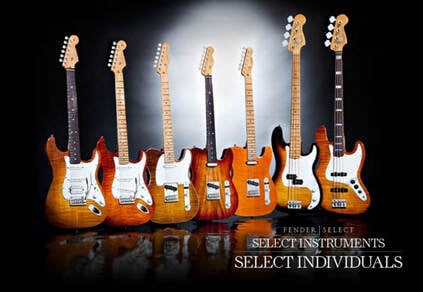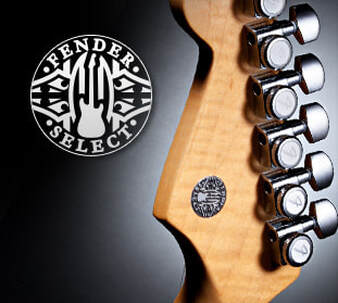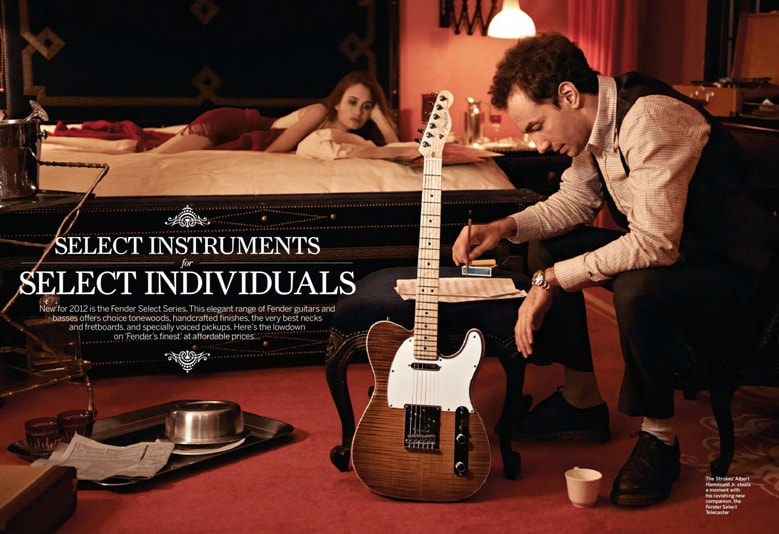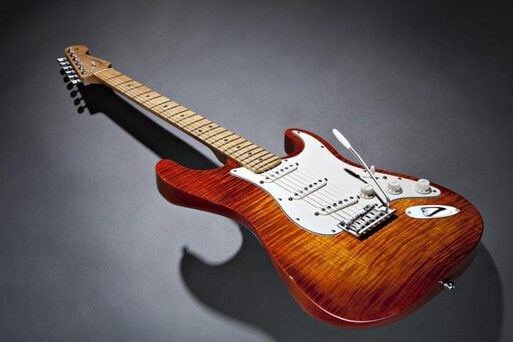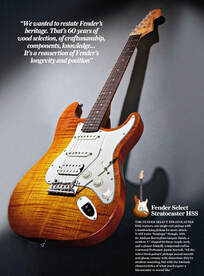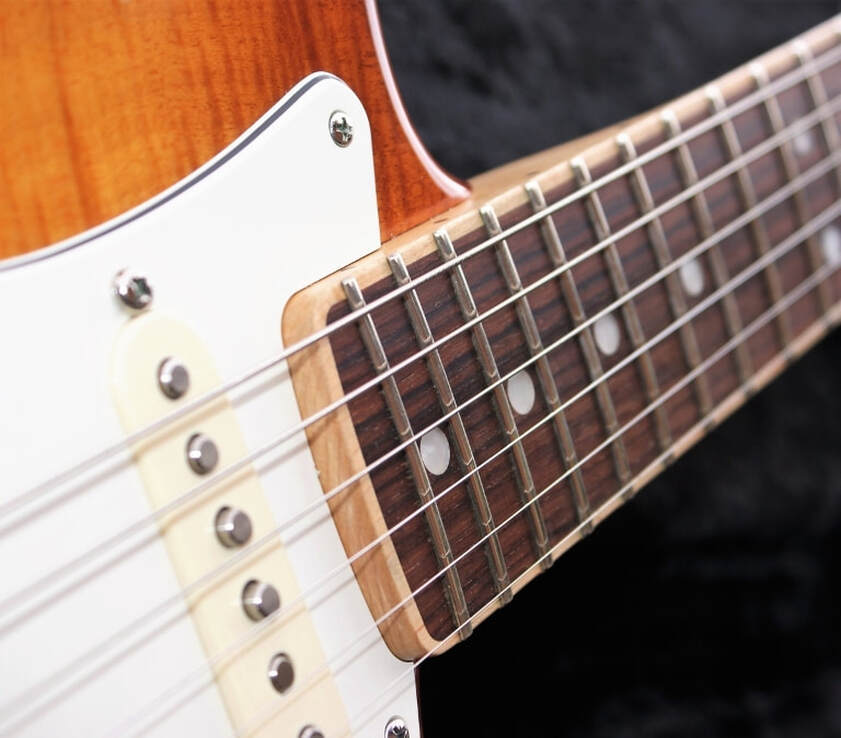|
Unveiled at NAMM 2012, these top of the line Fender Select Series guitars were the culmination of Fender's more than 60 years worth of guitar making experience.
Designed as “Select instruments for select individuals”, this elegant range of Fender guitars and basses was a dramatic breakthrough for Fender production-line instruments, as everything from woods to electronics was designed to be seriously elegant and sonically spectacular — a luxury line that stopped short of the wonders of the Fender Custom Shop, but still made you feel like you’re wielding a custom machine. |
With the US-made Fender Select, you had a choice of fine tone woods, unique figured tops, handcrafted beautiful finishes, quartersawn or figured maple necks with compound-radius fretboards, pearloid position inlays.
Fender Select currently stands as Fender's finest guitar production series, and was stamped with a rear headstock Fender Select medallion.
The Select Series was a “bridge”, if you like, to the Custom Shop guitars and presented a new, luxurious take on a classic and Fender's finest selection at “affordable prices”.
Fender Select currently stands as Fender's finest guitar production series, and was stamped with a rear headstock Fender Select medallion.
The Select Series was a “bridge”, if you like, to the Custom Shop guitars and presented a new, luxurious take on a classic and Fender's finest selection at “affordable prices”.
|
Fender has taken a cinematic turn in the launch of its new high-end Fender Select series of electric guitars with a highly stylized print campaign featuring Strokes guitarist Albert Hammond Jr. and a slick new short fictional film titled "Selected"
|
Justin Norvell, Vice President of Marketing for Fender Electric Guitars, explained the reasoning behind Fender’s Select Series. “Larry Thomas (Fender CEO) is pushing us to expand the scope of what Fender can do, while still recognizing its legacy. For example, the Fender Select series really kicked off when Larry looked around and said, ‘Why don’t we have top-of-the-line production-model guitars made with really fine woods?’” said Norvell. “Fender makes a lot of guitars, and it can sometimes be confusing to differentiate between a lot of the models. We wanted to make a capstone to the product line – high-end and beautiful. There have been a lot of ‘boutique’ companies who, shall we say, ‘work on our platforms’, so we wanted to restate Fender’s ‘60-year heritage. That’s 60 years of wood selection, of craftsmanship, components, knowledge… This series is a reassertion of Fender’s longevity and position, and of the fact that we are looking forward as well as back.”
Who were these Fender Select Series guitars for? Norvell said, “The idea is, if someone walks into a dealer, and they haven’t spent weeks researching the nuances of all the models Fender makes, but just asks: ‘What’s the best one?’ Well the Select Series is pretty much it. They’re guaranteed to sound good, they have the best woods, the best pickups… that’s the vibe.”
Who were these Fender Select Series guitars for? Norvell said, “The idea is, if someone walks into a dealer, and they haven’t spent weeks researching the nuances of all the models Fender makes, but just asks: ‘What’s the best one?’ Well the Select Series is pretty much it. They’re guaranteed to sound good, they have the best woods, the best pickups… that’s the vibe.”
The Fender Select Series boasted all-new specially voiced Fender Select pickups. “We started with the most highly regarded, best-selling pickups in our line. We zeroed in on some of the Custom Shop pickups: the Fat ’50s, the Broadcaster pickups for Tele guitars, the ’60s Jazz Bass pickups. We adjusted the windings, all sorts of things. We wanted each pickup to give the best of all worlds,” said Justin Norvell.
The series also employed the BiFlex truss rod system which helped with stability, and the no-load tone control facility that delivered the uncolored tone of the bridge pickup even when dimmed.
The series also employed the BiFlex truss rod system which helped with stability, and the no-load tone control facility that delivered the uncolored tone of the bridge pickup even when dimmed.
THE FIRST SELECT STRATOCASTERS
|
The Fender Select Stratocaster looked like a classic Strat, but with its Dark Cherry Burst gloss-lacquer finish and natural binding on a flame maple-topped body, it looked pretty opulent.
The new maple-topped bodies have been a tricky proposition, said Norvell: “We’ve had to reinvent a lot to produce the Select Series. The carved tops have been a challenge, the compound-radius fretboards on this scale of production was a challenge. And the finishing was a challenge. The stains on these guitars are all rubbed-in by hand. It’s not a regular paint process, but it helps the great sunken-in grain look. This isn’t just paint on top of a wood grain.” |
Its modern “C” shaped flame maple neck had a comfortable contoured heel, BiFlex truss rod system for rock-solid stability, a satin lacquer back finish and rear-headstock "Fender Select" medallion.
The smooth-playing compound radius flame maple fretboard (9.5"-14") had 22 medium jumbo frets, stylish black pearloid position inlays and a gloss lacquer finish.
Other premium features included a two-point synchronized tremolo bridge with vintage-style bent steel saddles and deluxe staggered cast/sealed locking tuners.
The smooth-playing compound radius flame maple fretboard (9.5"-14") had 22 medium jumbo frets, stylish black pearloid position inlays and a gloss lacquer finish.
Other premium features included a two-point synchronized tremolo bridge with vintage-style bent steel saddles and deluxe staggered cast/sealed locking tuners.
|
The Fender Select Stratocaster HSS shared the same features, with several notable exceptions: it replaced one single-coil pickup with a Fender Select humbucking pickup for more attack. It still looked “boutique” though, with its Antique Burst gloss-lacquer finish, a modern “C”-shaped bird's eye maple neck, white pearloid position inlays, and a player-friendly compound-radius rosewood fretboard. Justin Norvell: “All the Select Strat guitars’ pickups sound smooth and glassy, creamy with distortion: they’re modern-sounding, but with the intrinsic characteristics of what you’d expect a Stratocaster to sound like.”
|
But these particular Fender Select Series won’t be around forever, as Justin explained, “I feel these are all special and collectible. And they’re limited. I feel the line will reinvent itself every year – what you see now won’t be in the line in 2013. Because by then, we’ll have new Select models. New designs, new woods, new innovations.”
2013: CHANNEL-BOUND NECKS
The 2013 Fender Select Series introduced the channel-bound necks. For those that don’t like to feel the ends of the frets when moving up and down the guitar neck, a bound neck is an option that can offer a smoother trip up and down the fretboard. Binding is the practice of taking a strip of material - typically vinyl - to line the outside of the fretboard. That material decoratively covers the end of the frets that press into the wood (otherwise known as the “tangs”) at the edges of the fingerboard. With the 2013 Select Series, Fender took that idea a step further with their unique channel-bound necks.
The channel-bound necks have a compound-radius fingerboard inlaid directly into the neck, eliminating the side seam between the neck and fingerboard. To achieve this seamless effect, the sides of the neck channel are actually angled inward in a revolutionary process to encase the fretboard and offer enhanced resonance between the neck and fingerboard.
“We were thinking about a way to inlay the fretboard like you inlay blocks,” said Justin Norvell. “It was just an idea, but it turned out that it gave you the cool look of binding with wood instead of vinyl. A lot of times with binding, there’s a hard edge to it, a hard corner that is not as comfortable. With channel bound, it’s sanded over and more rounded, giving you a great feel.”
The channel-bound necks have a compound-radius fingerboard inlaid directly into the neck, eliminating the side seam between the neck and fingerboard. To achieve this seamless effect, the sides of the neck channel are actually angled inward in a revolutionary process to encase the fretboard and offer enhanced resonance between the neck and fingerboard.
“We were thinking about a way to inlay the fretboard like you inlay blocks,” said Justin Norvell. “It was just an idea, but it turned out that it gave you the cool look of binding with wood instead of vinyl. A lot of times with binding, there’s a hard edge to it, a hard corner that is not as comfortable. With channel bound, it’s sanded over and more rounded, giving you a great feel.”
Antonio Calvosa

